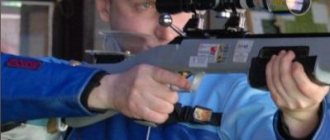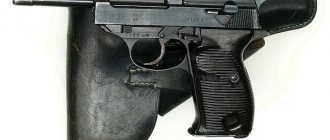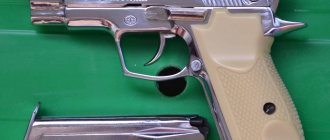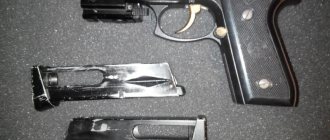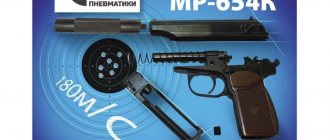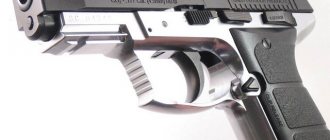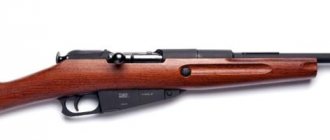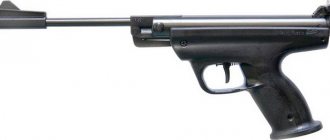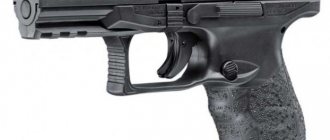To fully study the structure of small arms, it is difficult to do without its weight and dimensions model, relying only on drawings and diagrams. The design cannot be the same for all parts of a firearm, so a good shooter will have to constantly study samples. Although in most cases, it is enough to know what types of pistols (weapons) there are.
Operating principles
The main difference between weapons lies in the different operating principles of the mechanism. Thus, some rifles are inflated with atmospheric air directly during loading, while others require refueling using a cylinder. There are also those who need to be “fed” with carbon dioxide canisters.
Spring-piston system
This principle of operation is the most common for modern air blowers. Since the design is simple to manufacture and maintain, such rifles are often low in cost, but have good muzzle velocity and allow accurate shooting at distant targets.
In order to fire a shot, the rifle must be cocked each time. This is usually done by breaking the trunk. At this moment, the spring is compressed, and the weapon comes into combat readiness. The moment the trigger is pressed, the energy of the spring is released and it begins to push the piston. Since its power is quite high, the latter accelerates to a speed of 15-20 meters per second.
This results in the creation of powerful compression pressure transferred to the charge. Typically a lead bullet weighing up to 1 gram is used. When the piston travels about 90 percent of the way, the bullet breaks off and begins to accelerate down the barrel. At this moment, the pressure can already exceed 200 atmospheres. All these factors ensure an initial bullet speed of at least 300 meters per second.
Gas cylinders
Such mechanisms are most often used on short-barreled pistols, although they are sometimes found in full-size rifles. The main source of energy for the shot is compressed CO2 gas, located in a durable cylinder under high pressure. Usually it is enough for 20-30 shots without loss of power, then the projectile begins to slow down.
A metal ball is usually used as a projectile; in rare cases, a lead bullet is used. The gas from the can constantly presses on the outlet valve. At the moment of firing, it opens for a short time, the duration of which depends on the power of the installed spring. As a result, carbon dioxide finds its way out through the barrel, in which the ball or bullet is already located. The projectile's flight speed varies between 100-120 meters per second.
Compression and multi-compression
The mechanics of this type of rifle are somewhat reminiscent of those in gas-cylinder systems. However, a compressed gas cylinder is not required here. The energy source is a reservoir, which is pre-inflated by the shooter using a special lever with atmospheric air.
The difference between a compression and multi-compression mechanism is that in the first case all the air is released in one shot, while in the second it can be enough to provide several shots with the same power.
When you pull the trigger, the release valve opens and the compressed air that escapes pushes the bullet down the barrel. The power of the shot can be adjusted using additional pumping. Typically, the speed of a bullet in such rifles is approximately 280 meters per second.
Pre-pumping (PCP)
It is an improved version of the multi-compressor system. It has a built-in or removable tank capable of maintaining pressure up to 300 atmospheres. It is pumped using a separate pump or a pre-prepared large-volume cylinder. Both atmospheric air and nitrogen can be used as a filler.
The tank capacity is enough for an average of 20 powerful shots. The bullet's flight speed after exiting the barrel is at least 350 meters per second when fully pumped. Most of these rifles are equipped with a reduction gear, as this allows shots to be fired at the same power for maximum time, and ensures long life of the exhaust valve.
Inflating the cartridge
Quite a rare, but practical system. It differs in that the loaded cartridges outwardly resemble those used in firearms. Only inside, instead of gunpowder, there is air compressed to 200 atmospheres. And at the exit there is a small lead bullet or metal ball.
At the moment of firing, the capsule is struck, which activates the release valve located in the cartridge itself. All the air is suddenly released, pushing the bullet forward down the barrel of the weapon. Since its volume is often small, these rifles are inferior in power to those described earlier. The initial speed of a bullet ranges from 100 to 140 meters per second.
Recoil
An important criterion when choosing an air rifle or pistol is the presence of recoil. When hunting or sport shooting, it can significantly complicate the process.
All types of “air guns” that use compressed gas of any type are practically devoid of this concept, since the power of the remaining air leaving the barrel after a shot is negligible. But systems with a spring-piston mechanism have quite strong recoil due to the internal movement of the heavy piston. If the bullet is heavy, it may not have time to leave the barrel before the piston hits the front edge of the chamber, which leads to poor shooting results.
Gas guns (GreenGas / CO2)
The most attractive type of airsoft weapon. Gas pistols in most cases are the most accurate copy of the firearm prototype both in size and weight. Shooting occurs through the use of gas energy: carbon dioxide CO2 or propane-based gas (greengas).
Models with simulated recoil (GBB) have a mechanism that allows the bolt to move during firing, like a combat prototype.
Non-recoil models (NBB) consume less gas, but their bolt carrier is correspondingly immobile.
on the left are Beretta 92 and CZ-75 pistols on CO2, on the right are Beretta 92 and CZ-75 pistols on greengas
Before you start shooting, you need to load the balls into the magazine, as well as charge the gas.
we load the balls using a loader and a special attachment for pistol magazines
At greengas - fill gas into the tank. For CO2 – install and screw in a 12 g canister until it’s tight.
charging gas into an airsoft pistol, greengas on the left, CO2 on the right
Principle of operation
insert the magazine, cock the bolt
- The shooter pre-cocks the bolt (in some models), while cocking the hammer (striker), and the gas chamber with the nozzle on the way back, under the action of the return spring, drives the ball from the magazine into the hop-up chamber.
- The shooter pulls the trigger, releasing the striker, which hits the release valve.
- The valve releases a stream of gas from the reservoir.
- Gas feeds the ball from the magazine into the hop-up chamber (in models with a fixed gas chamber), and then blows it out through the barrel. A shot occurs, and in GBB models the bolt is also rolled back to the rearmost position and returned to the front position with the ball loaded into the barrel.
Main components
pistol WE Glock 19 gen.3 (gringaz) disassembled
- gate
- pistol frame
- outer trunk
- shop
- inner stem
- hop-up camera
- gas tank
- gas chamber
- return spring
- Exhaust valve
- filling valve (for greengas models)
Difference between greengas and CO2 models
- Green Gas - the tank for green gas is located inside the gun (usually in the store) and gas is filled from the cylinder inside through the filling valve.
- In CO2 samples in the store, or inside the pistol handle, there is a compartment for installing a standard 12 gram carbon dioxide cartridge. The canister is pressed with a screw until it is pierced by the needle of the gas chamber.
Service
It consists of lubricating the moving parts with silicone grease. In CO2 models - shooting a service can with silicone 1 time per 10 regular cans.
Important!
After firing CO2 pistols, when storing them, it is necessary to remove the cartridge, even if it is not used up, to avoid damage to the seals.
In models with green gas, it’s the other way around - you need to leave a small amount of gas in the magazine so that it does not allow the seals to dry out.
Disassembling and repairing an airsoft pistol is essentially not difficult, but we still recommend that maintenance be carried out in workshops by professional airsoft specialists in order to avoid breakdowns and failure of the pistol. Unless, of course, you yourself have the necessary skills =)
© Airsoft Planet, 2022 Partial or complete publication of material without attribution is prohibited.
Share:
Charging and injection systems
They are divided into manual and automatic. The former are most often used only on rifles, but are occasionally found in short-barreled weapons. In order to cock such a pistol, you need to break the barrel or use a special lever. This allows you to not depend on consumables during shooting, but significantly increases the time between shots. In addition, it usually requires a lot of effort, resulting in reduced accuracy.
Automatic systems are all rifles that use pre-pumping or consumables in the form of gas cartridges. They allow you to shoot almost continuously, but require either additional equipment or a supply of cartridges.
USM
The presence of a trigger mechanism is mandatory in any type of weapon. But in some types of pneumatics, only the trigger is used due to the uselessness of the blow itself. This allows you to get rid of excessive recoil and increase shooting accuracy, as well as simplify the design, which has a positive effect on its maintenance.
Impact mechanism
The use of an impact device is more relevant for pistols and rifles with pre-pumping or additional equipment with a container of compressed air. The principle of operation is extremely simple - at the moment when you need to fire a shot, the trigger hits directly the exhaust valve, which leads to its opening. The compressed gas is released, but the valve returns back under the influence of the spring, and the process can be repeated again.
In order for the blow to have sufficient force, it is transmitted using a mainspring. The more powerful it is, the longer the exhaust valve will be open. Increasing power leads to greater gas consumption, but allows you to achieve an initial bullet speed of 180 meters per second even on short-barreled pistols.
Mainsprings are divided into plate and screw. This is not to say that one type is better than the other, it is simply a design feature. The hammer itself is located between the trigger and the valve stem. In order for the spring to be cocked, a trigger sear is used.
The trigger can be made in both open and hidden versions. In the first case, the shooter has the opportunity to cock it manually, in the second, everything is given to automation.
Trigger
It is used in single-shot weapons and is intended to keep it cocked until the moment of release. Manufacturers strive to achieve maximum smoothness of its operation, since shooting accuracy and recoil power directly depend on this.
All trigger mechanisms that are used in modern air guns are divided into three main types:
- Single action. A distinctive feature is the need for an initial cocking of the hammer, and only after that the shot becomes possible.
- Double acting only. An automatic system with self-cocking, in which, at the moment the trigger is pressed, the trigger pulls the trigger, which leads to a strike on the valve using the mainspring. Arming does not occur and is performed manually by the shooter each time.
- Double action. A universal system that combines the two previous ones. As a result, the shooter can either use automatic weapons or cock the hammer manually.
It is worth noting that when shooting with self-cocking, much more force is required, which negatively affects shooting. This point must be taken into account if you plan to participate in competitions.
Reichsrevolver M-1879 (Reichsrevolver M1879 and M1883)
Look
The German Reichsrevolver M-1879 was intended to arm the army. The revolver was in service with the German army from 1880 until 1908, when it was replaced by the Parabellum P08 pistol. During the First World War, the revolver was in service with the rear units of the German army, and was also used at the final stage of the Second World War; it was armed with the Volkssturm militia. The 10.6 mm revolver cartridge was on sale until 1939. The design of the revolver was initially designed to be simple and massive, suitable for mass production. Almost all German arms companies produced Reichsrevolver. The trigger mechanism allows firing only with manual cocking of the hammer.
Circuit breakers
As with firearms, air pistols and rifles must be protected against accidental discharges as the bullet's power is sufficient to cause serious injury. Globally, non-automatic fuses can be divided into two separate types.
The first is the locking trigger mechanism. When the weapon is put on safety, one of the key parts is blocked, as a result of which the descent becomes impossible. The trigger also becomes motionless.
The second is the separating firing mechanism. This type of fuse simply breaks the connection between the trigger and the rest of the system. As a result, you can press on it, it remains mobile, but the shot will not occur. This system can be compared to placing a car's transmission in neutral, in which the engine is disconnected from the transmission.
In addition to them, there are also automatic versions of fuses. In this area, manufacturers are constantly experimenting and offering unusual solutions. So, for some pistols, the shot will not occur without the full grip of the handle. Others block the release if the bore is not closed.
There are additional security methods. Some pistols are equipped with special indicators that show whether they are on safety or not. Some of them can be unloaded without firing the final shot, which can also be useful, especially if the pistol needs to be disassembled for servicing indoors.
Revolver Lebel arr. 1892
Look
French revolver mod. 1892 is similar in design to the Colt system revolver, but the cylinder is tilted for loading and unloading not to the left, but to the right. The drum is locked by a trigger and a locking device of a slightly different device. A special feature of this revolver is its ease of disassembly. To disassemble, unscrew the connecting screw and turn the left wall; After this, the revolver will be completely open and can easily be disassembled in a manner similar to disassembling a Colt revolver. In addition, the revolver had an “Abadi door” for alternate loading of cartridges. According to A.B. Zhuk, simultaneous extraction of cartridges with the drum folded back was present, but the introduction of cartridges into the chambers of the drum was carried out one by one (as with Nagan revolvers). The revolver was in service with the French army along with old French revolvers mod. 1873-1874 The design, in general, is quite perfect for its time, but the ideas that guided the gunsmiths when deciding the issue of preloading are not entirely clear. One caliber with a rifle made it possible to use defective rifle barrels in revolver production, but the caliber did not quite provide sufficient stopping power. The problem is similar to the problem of Nagan revolvers in Russia, where the same principle of a single caliber was laid down.
Dispensers
This type of equipment is used on weapons with pre-pumping or gas cartridges. Its task is to release a limited amount of gas into the barrel at the time of cocking or firing, depending on the design.
Gas cylinder systems
In most gas-operated guns, the dispensers look and operate the same. To ensure proper functioning, the dispenser has three different openings. The first of them is intended for installing a can and is equipped with a special sealing gasket and a needle for piercing the membrane.
After the canister takes its place and is punctured, the gas enters a special chamber, behind which the release valve is located. Due to the high pressure, the valve does not allow gas to pass through until the release occurs. When the trigger is pulled, the trigger hits the stem, causing the valve to open. It returns to its place under the action of a spring and pressure.
The stronger the spring, the stronger the shock, and the longer the valve will remain open. Therefore, the spring itself and the stiffness of the valve can be considered the main metering devices of a pistol with gas cylinder equipment.
There are systems that do not have a third hole for the rod. In this case, the descent occurs due to the impact of the barrel itself with a weight on the exhaust valve.
Pre-pumped systems
Since the pressure in such a weapon can vary from shot to shot, it has two additional features. The first is a built-in reducer that controls the pressure directly in the dispenser chamber. Due to this, it is possible to maintain approximately the same power over several shots.
When the number of atmospheres in the container begins to decrease, the valve no longer fits so tightly, which can lead to a smooth release of air. To prevent this, additional pressure of the valve to the gasket is provided using a spring.
Trunk
Not only the comfort and accuracy of shooting, but also the ease of its maintenance and cleaning depends on exactly how and how well the barrel is made. This is especially true for rifled barrels, which are used in most rifles and pistols.
Generally, the barrel design can be divided into three main parts:
- Threaded part;
- Pool entrance;
- Chamber.
The last of these elements is rare, since it is used only in weapons with a pre-pumped cartridge. In other models it is simply not necessary.
The bullet entrance is usually made in the form of a truncated cone, and is designed to correctly position the bullet or ball in the barrel before firing. This feature is easiest to notice in a single-shot rifle, which is cocked by breaking the barrel. The bullet is placed in place and held there securely until fired, and does not roll deeper down the barrel precisely due to its conical structure.
The rifled part is responsible for giving maximum acceleration and spinning of the bullet. Due to rotation, a fired bullet can cover a greater distance without losing speed, and fly much more accurately.
Most air rifles are made in 4.5 mm caliber because it does not require any special approval. But on sale you can also find “air guns” designed for firing bullets of larger calibers, up to 14.5 mm. Their exploitation is already associated with bureaucratic difficulties. They are usually used for hunting and have a pre-inflation system.
Lead bullets are used to fire rifled weapons; it is prohibited to use steel balls in them, since they are harder and can damage the barrel. In turn, the latter itself is made of steel. It is less common to find weapons with brass barrels.
In order to increase shooting accuracy, it is recommended to use rifles with a fixed barrel. More expensive models, which still use movable barrels, have compensation equipment, which is also used in conventional firearms.
Automation systems for self-loading firearms (Part 1)
I don’t remember in the comments to which article and by whom, but it was proposed to make several materials that would describe the basic principles of the operation of firearms, as well as individual nuances of a particular system. This was proposed in the context of popularizing weapons, since for many, the automatic system with a long barrel stroke and the blowback bolt are just a bunch of words and nothing more. Well, we don’t even need to mention the fact that people pull the trigger and so on. Let's start right away with the complex ones, namely with automation systems, since, having understood them, people will at least have an understanding of how this or that model works.
Usually in weapon reviews I try to at least briefly describe how automation works, but sometimes there are several articles in a row about weapons with the same automation system, as a result, writing the same thing is not at all interesting, and I don’t always want to describe in detail what and how and where it is moving.
In this material I would like to cover at least what has been and is being used in firearms at the moment, naturally with specific examples. The material will be large, sometimes tedious, I will try to write without using terms, that is, roughly speaking, I will explain it on my fingers. So, anyone in the subject can safely skip the article, since you won’t learn anything new from it, but anyone who wants to figure out how and what works should definitely read it. Maybe new visitors will be added due to this article in the sections “Individual Weapons” and Sniper Weapons,” otherwise we are sitting here with our little group and will expand. Automation system with free shutter.
Let's start with the simplest thing, namely the blowback automatic system. The closest example to our compatriots would be the Makarov pistol; in addition, the blowback bolt is often used in submachine guns and in those models that use low-power ammunition. In pistols, blowback is used mainly with cartridges with low kinetic energy of the bullet; the limit for such a system can be called 9x19 ammunition, for which there are several models of pistols with automatic blowback. But such weapons literally operate at the limit of their capabilities, which is why their service life is very short, and the requirements for the quality of materials are very high, which naturally affects the cost. If we talk about submachine guns, then in them the automatic blowback system is used more widely and with a wide variety of ammunition. But first things first.
Automation system with blowback for pistols.
We will disassemble the automatic system with a blowback for pistols using the same PM as an example, since for people interested in weapons there will always be an opportunity to get acquainted with this pistol due to its wide distribution, at least in the “traumatic” version, which does not differ in the automatic system from the original . Inside the weapon casing, the very part that is pulled so that the cartridge from the magazine moves into the chamber, the uppermost movable part of the pistol, there is a bolt, therefore for most pistols the description says not just a bolt, but a casing-bolt, since these are two parts tightly connected to each other. There are variants of pistols where the bolt is represented as a separate independent part, but there are not many of them. Despite the fact that the automatic system is blowback, the bolt is actually not that free, its movement is prevented by the weapon's return spring, which in the Makarov pistol is wrapped around the barrel. The return spring rests against the front part of the bolt casing, so in order for the bolt casing, and therefore the bolt itself, to be in its rearmost position, it is necessary to compress the return spring. Well, now how does it all work.
As you know, a bullet moves along the bore due to the fact that gunpowder, during its combustion, releases combustion products in a volume significantly exceeding the volume of the gunpowder itself. Due to this phenomenon, the pressure between the case and the bullet increases very quickly, and therefore more volume is required to reduce this pressure. The increase in the volume free for powder gases occurs precisely due to the fact that the bullet moves along the barrel and the distance between the cartridge case and the bullet increases. To make it more clear, you can imagine all this in the form of a piston, but with one caveat. Powder gases, expanding, put pressure not only on the bullet itself, but also on the walls of the barrel bore, as well as on the bottom of the cartridge case. If the cartridge case were not supported by the bolt, it would fly out of the chamber in the same way as the bullet, but since the weight of the bolt, casing and cartridge case is greater than the weight of the bullet, and plus the entire casing-bolt does not allow the return spring to move freely, the cartridge case remains in the chamber.
It would be quite timely to ask how recharging occurs in this case. I’ll try to explain it back using a simpler example. If you take two metal balls with a large difference in mass and put a compressed coiled spring between them, then when the spring straightens and pushes the balls, they will move at different speeds, and if the difference in weight is very large, then one of the balls may even remain on place. In our case, to ensure trouble-free and correct operation of the weapon automation system, it is necessary to ensure that the bolt casing moves after the bullet leaves the barrel, that is, so that it is not the powder gases that push the cartridge case with the bolt, but the heavy bolt casing due to of its mass, retaining the energy received through the cartridge case from the powder gases, pulled the cartridge case out of the chamber. I feel like I’ve piled up a forest, “imagine this, imagine that,” because the lite version of the description of the operation of the automatic blowback system:
When fired, the powder gases expand, push the bullet at high speed along the barrel, pressing on the cartridge case, which transfers the energy received from the powder gases to the bolt casing. Due to the greater mass of the bolt casing, in comparison with the bullet, its speed is much lower than the speed of the bullet, but due to the greater mass, the bolt casing picks up speed more slowly, which is why it is often said that the bolt casing begins to move after the bullet has left trunk, which is not entirely true. Thus, the automation system can be represented as a system with two movable pistons in one cylinder, differing in the force required for their movement. Well, speaking roughly and not taking into account the fact that one of the pistons continues to move even when the second one jumped out of the cylinder and the pressure in it returned to normal.
Well, to make it completely clear, let’s try to go through the points of what happens when a shot is fired using the example of a Makarov pistol: 1. The gunpowder ignites and begins to burn, increasing the pressure between the cartridge case and the bullet. 2. The bullet moves along the barrel, picking up speed, and the bolt casing begins to accelerate very, very slowly, almost imperceptibly. 3. The bullet leaves the barrel of the weapon, the bolt continues to move due to its mass, even though there is nothing else pushing it through the cartridge case. As the shutter moves, the return spring is constantly compressed. 4. The bolt housing removes the spent cartridge case from the chamber and throws it through the spent cartridge case window. 5. Having reached its rearmost point, the bolt casing cocks the weapon and stops. 6. Since the return spring is compressed, after stopping the bolt casing it tries to straighten, as a result the bolt casing begins to move forward. 7. During the movement of the bolt casing, a new cartridge is removed from the magazine, which is simply pushed forward. 8. The bolt housing inserts a new cartridge into the chamber and stops.
Despite the fact that everything is really very simple, even such an automation system may not work correctly. Above was an example with two metal balls of different masses, between which a compressed spring was placed. This example most clearly demonstrates two options for the malfunction of the weapon automation system. In the first option, when one of the balls is too heavy in comparison with the second, it simply will not budge. In our case, this will mean that the bolt casing will simply support the cartridge case and reloading will not occur. In the second case of incorrect operation of the automatic blowback system, the bolt may begin to move even before the bullet has left the barrel; accordingly, the thin walls of the cartridge case will take the entire “blow” from the powder gases and most likely will not withstand or become deformed. Both are not good for us, since a deformed or torn cartridge case can jam the bolt casing, and the powder gases that have broken through the torn cartridge case, instead of pushing the bullet down the barrel, will simply go into the air, and accordingly the bullet will move more slowly.
It may seem that ensuring the correct operation of the automation system is an incredibly difficult task associated with the accurate calculation of the weight of the shutter casing, but this is not so. In the case of balls of different masses, between which a compressed spring is placed, we can really “play” only with weight and nothing else. In the case of a pistol, we have another opportunity to influence this system, namely through the return spring. Since the return spring is directly connected to the bolt casing, by changing its rigidity, we can change the speed of movement of the bolt casing without changing its weight.
Naturally, there are no examples of malfunctioning automation systems in military weapons, since such samples are designed by specialists and such “childhood diseases” are a shame for the designer. And military ammunition is more or less stable in energy. You can encounter incorrect operation of the automatic blowback system in pistols only in very old models or in cases of outright defects in the production of weapons or ammunition. But there is an opportunity to look at this disgrace. A traumatic weapon provided this opportunity. Let me make a reservation right away that the reason for the incorrect operation of the automatic blowback system in a traumatic gun is not an error in the design of the weapon. The real reason is that traumatic cartridges have a very large spread in their kinetic energy. Here's an example. The weapon is designed to use fairly powerful ammunition, the seller decided to sell the owner of the pistol very weak cartridges, praising them and calling them ideal for training shooting, and that’s the inscription on the box “Training”. Having decided to shoot and hone his skills, the owner of the pistol suddenly discovered that his pistol had turned from a self-loading one into a weapon with manual reloading, since the energy of weak cartridges was not enough for the bolt to move all the way back. Naturally, the pistol and the manufacturers are “to blame” for this, but if you replace the recoil spring with a weaker one, then everything will work like clockwork. Or the opposite example. Weapons designed for weak cartridges are loaded with more powerful ones. As a result, the shell casings look like something unknown when fired, and the gun itself periodically fails due to stuck shell casings. Let us omit the point that in weak samples, not only is the automation system designed to use weak cartridges and the use of more powerful ones will lead to damage to the weapon, but in this case, a stiffer return spring will ensure reliable operation of the automation system, although not for long.
In general, the automatic blowback system has proven itself in pistols as the simplest and most reliable, and if not for restrictions on the power of ammunition, the blowback would have become the most common in pistols. However, they were once the most common when self-loading pistols first appeared.
Automatic system with blowback for submachine guns.
In submachine guns, the blowback breech has occupied its leading place in distribution, and continues to do so, although other automatic systems are trying to supplant it, while the leadership remains with it. The reason for this proliferation lies not in the fact that only low-power cartridges are used in blowback-type SMGs; there is a much greater variety of ammunition here, but in the fact that the designers found solutions that were unacceptable in pistols.
The simplest solution to the problem is a long shutter stroke. Everything works exactly the same as in pistols, but the bolt has a longer stroke, which reduces the load on the weapon parts. Unfortunately, this is difficult to apply in pistols, since the dimensions of the weapon will increase sharply. An example of such an automation system would be the domestic Kedr submachine gun, which you can also get acquainted with using the example of its traumatic variant Esaul, although it is not very common and does not have the ability to conduct automatic fire, so the acquaintance will be incomplete.
A much more cunning method is an automatic system in which the shot occurs from an open bolt. In the previously discussed options, the normal position of the bolt before firing is its extreme forward position, when it rests against the breech of the barrel, but in this case everything is exactly the opposite. The normal position of the bolt is its rearmost position, with the return spring compressed. Thus, when fired, the bolt is released, on its way forward it picks up a cartridge from the magazine, inserts it into the chamber and breaks the primer.
This automation system has both its pros and cons. The positive aspects include the fact that the weapon can use fairly powerful ammunition while maintaining a relatively short bolt stroke. This happens because in order for the bolt to start moving in its opposite direction, it must first be stopped, that is, part of the energy of the powder gases is spent on stopping the bolt and part on making it start moving backwards. The negative quality is that the moving parts of the weapon knock it away from the aiming point even before the shot is fired, therefore the weapon becomes less accurate. I'll try to describe point by point how it all works. 1. The bolt is in the rearmost position, the chamber is empty, the return spring is compressed. 2. The bolt begins to move forward, picking up a new cartridge from the magazine. 3. The bolt inserts a new cartridge into the chamber and breaks the primer. 4. A shot occurs, powder gases push the bullet down the barrel, and also brake the bolt through the sleeve. 5. The bolt stops 6. The bolt, having received energy from the powder gases through the sleeve, begins to move backward. 7. The bolt removes the spent cartridge case from the chamber and ejects it. 8. Having reached its rearmost point, the bolt stops, compressing the return spring (for single-fire mode).
In general, everything is simple, one might even say that everything is the same, just the numbering of actions has been shifted. An example of the use of such an automation system could be at least PPSh. The blowback automatic system is essentially the first automatic system, on the basis of which the first self-loading weapons were made, so we can say that this system is one of the oldest. Despite all its limitations in ammunition power, it still remains a fairly common system, and its reliability and ease of production force many weapons manufacturers to pay attention to it.
Automation system with fixed shutter.
Unlike the previous automation system, a fixed bolt is very rare, one might even say that it does not occur at all, but since such an automation system exists, it cannot be missed, especially since it, like the previous one, does not rigidly lock the barrel bore , so in some ways they are similar. At the same time, the automatic system with a fixed bolt is a kind of exception, since all other options used in self-loading weapons cannot do without it. There are very, very few weapons with such an automatic system; the most famous is the Mannlicher M1894 pistol.
There is no need to describe this automation system for a long time; everything works very simply and clearly. As you know, there are rifling in the bore of a weapon, and the bullet itself must pass tightly enough along the bore for the most efficient use of powder gases. Thus, if the barrel of a weapon were movable, then when fired, the bullet would push it forward due to the frictional force that arises as it passes along the barrel. It is on the basis of a movable barrel that automation with a fixed bolt works. In other words, instead of using a moving bolt for reloading, pushed by the energy received from the powder gases, a completely different operating principle was used, in which the powder gases, although they participate, are not directly related to the automation system. It all works as follows.
1. When the powder charge is ignited, the bullet begins to move along the barrel, pushed by the powder gases, while the barrel of the weapon, having a greater mass than the bullet, also begins to move forward, but this is almost imperceptible. 2. The bullet leaves the barrel of the weapon, and the barrel itself, having received sufficient energy from the bullet to roll back completely forward, begins to move, compressing the return spring. 3. The barrel moves forward, releasing the spent cartridge case, which falls out, having received the long-awaited freedom, on its own, or pushed by a spring-loaded element. 4. The barrel reaches its extreme forward point, compressing the return spring as much as possible. 5. Under the action of the return spring, the barrel begins to move back, while it picks up a new cartridge from the chamber. 6. The barrel rests against a stationary bolt and the weapon is ready for the next shot.
As is clear from the description, there is nothing difficult to connect the movable barrel with the trigger of the weapon for its automatic cocking, or to introduce a double-action trigger mechanism. This automation system is quite interesting and simple, but its implementation requires very precise adjustment of parts, in particular the barrel and frame, so that the movement of the barrel does not affect the accuracy of the weapon. Naturally, the durability of the weapon will depend on the quality of the materials used, and in this case it is in any case subject to very rapid wear. Thus, weapons with such an automation system will need constant lubrication, will be very susceptible to contamination and will not last long, even with the highest quality production. Actually, this was the reason that weapons with such an automation system are very rare.
For the first part of the material on weapon automation systems, I think it will be enough, but there is still a lot of interesting things ahead.
PS The first photo is not a suicide club, people are holding ice cream in the shape of pistols.
Locking
The shutter is very rare in pneumatics, at least in its classical sense. Here, this system has a slightly different task - it must ensure blocking the release of gas after a shot in multi-shot rifles and pistols.
Gas pistols often use a system of retractable bushings that return the valve to its place in time. A simpler solution is to use a moving barrel, but this leads to a decrease in shooting accuracy.
Nutrition
Due to this mechanism, air pistols and rifles have the ability to avoid manual loading after each shot. Multi-shot models have a manual or automatic method of loading a bullet. In its turn. Projectiles can be automatically fed using two methods: gravitational and forced.
Gravity feeding can be used for explosive balls, however, they must be of high quality. When using it, the bunker is located at the top of the weapon. A similar principle is used in airsoft and paintball drives to ensure rate of fire and ease of reloading.
Forced feeding is ensured through the use of magazines with a conveyor or spring-loaded mechanism. Such stores can be equipped in advance and contain enough balls to consume an entire cylinder of compressed carbon dioxide.
In the case of bullets, the best option is to use a revolver-type drum, since they are quite soft. Some manufacturers have tried to produce pistols with spiral-fed magazines, but this design is difficult to maintain and less reliable, so it is extremely rare.
In some cases, pistol magazines inserted into the handle also contain a valve assembly. This allows you to equip each of them with a can in advance, so that later during shooting you do not have to count the number of shots until the power decreases.
Pistol "FL Selbstlader"
Look
The FL Selbstlader pistol was a completely ordinary 7.65 mm blowback pistol. Its only curious feature was the shutter, which was made as a separate unit from the casing. The barrel was threaded to the frame, and the return spring was placed in the upper part of the casing, held above the breech by a fixed clamp. The shutter moved in the grooves of the frame, the cutout in the right side of which formed a rather large window for ejecting cartridges, which is why the shutter did not have sufficient support. The coupling of the bolt to the casing was ensured by a clamp attached to the casing on a hinge and connected to the bolt using protrusions and a large screw at the end of the latter. It was this design feature that served as the basis for registering a patent application for the invention.
Automation
If previously most air rifles were single-shot spring-piston mechanisms, now you can find many automatic and semi-automatic offers on sale.
Pistols equipped with the BlowBack system are fully automatic and autonomous, which allows continuous shooting until the magazine is completely empty. On the shelves you can find rifles with a bolt action similar to that used on sniper firearms.
From this we can conclude that in terms of automation of the charging and cocking process, air guns have already fully achieved the progress that is in the case of firearms.
Aim
Initially, rifles and pistols can be equipped with simple sighting devices, such as grooves, sighting bars with front sights and the like. However, all modern models have the ability to install additional equipment due to the provided mounts.
Thus, any sight designed for a firearm, from a collimator to powerful optics, can be installed on the air gun. Some pistol models also have this capability, and are even equipped with optics directly from the manufacturer. Therefore, the shooter himself can choose which type of sight to use.
Hold
The same elements used in firearms are used to hold air rifles and pistols. In the case of the former, this is the stock, forearm and butt. Sometimes there is a rubber butt pad in the rear, which is designed to reduce the recoil of the most powerful models.
The pistols have a comfortable handle, which also serves to place a carbon dioxide cylinder inside the magazine. Some models, modeled after submachine guns, may have a folding or clip-on stock.
Mauser C96
Look
Military pistols of the Mauser system, which first appeared in 1896, gave a great impetus to the development of automatic weapons and are currently being adopted by a number of countries with minor design changes. Pistol of the Mauser system mod. 1902 was modernized in 1908 and was adopted into service in Germany, first under the name “Mauser pistol mod. 1902”, and then under the name “Mauser pistol mod. 1908." The modernization increased the power of the pistol and the length of the barrel, and also changed the design of the sight. Mauser pistols mod. 1902-1908 were in service with armies in England, Italy, Czechoslovakia and other countries. The pistol is a type of automatic weapon using recoil of the barrel and bolt with a short barrel stroke. The complete withdrawal of the bolt after disengagement from the barrel is carried out due to the acquired speed of joint movement and mainly due to the residual pressure of the powder gases. The barrel bore is locked using a locking latch (cylinder) that rotates in a vertical plane. Trigger-type impact mechanism with open trigger position. The mainspring is mounted inside the pistol frame and simultaneously performs the functions of a barrel return spring. The trigger mechanism allows only single fire. Some samples of pistols, made to special order, also have continuous fire.
Additional items
Airguns can be upgraded and improved with certain types of additional equipment. Here are four examples of devices that can help you achieve higher accuracy and shooting comfort:
- Silencers. Used in models with pre-pumping. They slightly reduce the power of the shot, but make its sound noticeably quieter, which is important for hunting. Some rifles may have false suppressors installed, which are subsequently replaced by shooters with full-fledged equipment.
- Shock absorbers. Used to reduce recoil on single-shot rifles with a spring-piston mechanism.
- Compensators. In most cases, they are installed for decorative purposes, but in powerful rifles they can reduce tilting at the moment of firing, which will improve shooting accuracy.
- Muzzle. It is made as a thickening at the end of the barrel, which makes it easier to reload, creates an additional reference point when aiming and simply decorates the rifle.
MAUSER PISTOL mod. 1914
Look
A characteristic feature of the design was the use of the striker as a reflector of the spent cartridge case, and also the fact that the magazine was designed to hold nine rounds instead of the usual six rounds for pocket pistols. The spent cartridges were ejected to the right and upward. Sights consisted of a front sight on the barrel and a permanent sight on the bolt housing. According to the military, a pocket Mauser bullet from seventeen meters pierced five inch pine boards (a Nagan bullet only three), when firing from a distance of twenty meters, the radius of the best half of the hits was 22 centimeters (the Browning 1906 had 26 centimeters). Compared to other models of this type, the Mauser was larger, but its convenience and high reliability made it very popular. One cannot fail to note the peculiar elegance of this weapon. In Russia it was called “Mauser number one”, in contrast to “Mauser number two” - the same pistol-carbine. By the beginning of the First World War, many officers, officials and private individuals purchased Mauser Number One for personal use. in Oberndorf could not complain about small orders, although it did not succeed in the Russian market as much as the Belgian Fabric National with its Brownings.
